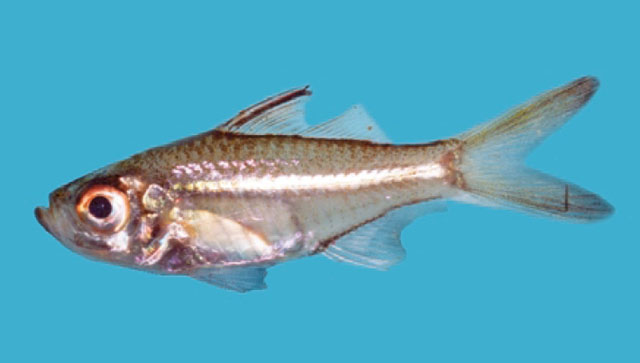|
Ambassis dussumieri Cuvier, 1828 Malabar glassy perchlet |

|
|
photo by
Keith, P. |
| Family: | Ambassidae (Asiatic glassfishes) | |||
| Max. size: | 10 cm SL (male/unsexed) | |||
| Environment: | demersal; freshwater; brackish; marine | |||
| Distribution: | Indo-West Pacific from Algoa Bay in South Africa, north to the Red Sea, Seychelles, and eastward around India and Australasia to the Philippines and China (Ref. 50956). | |||
| Diagnosis: |
Dorsal spines (total): 7-8; Dorsal soft rays (total): 8-10; Anal spines: 3-3; Anal soft rays: 8-11. Diagnosis: Ambassis dussumieri has the following combination of characters: supraorbital spines 1-5, usually 3-4; rostral spine present; rear margin of preopercle smooth (at least dorsally); interopercle edge smooth; two rows of cheek scales; predorsal scales 13-16; lateral line discontunuous; lower gill rakers 22-25; pectoral-fin rays 14-16 (Ref. 50956). Description: Dorsal fin with 7-8 spines and 8-10 soft rays; anal fin with 3 spines and 8-11 soft rays; pectoral fin with 14-16 rays (Ref. 50956, 52193). Lateral line with 12-14+10-16 scales, interrupted below base of soft dorsal rays by 1-3, usually 2, tubeless scales; vertical scale rows 27-28; horizontal scale rows 9-10; cheek scale rows 2; predorsal scales 13-16, 11 or 12 in some early juveniles (Ref. 50956). Gill rakers 8-10+22-25 (Ref. 50956). Supraorbital spines 1-4, more numerous and more pronounced in larger specimens; preorbital ridge smooth or with 2-3 small serrae; preorbital edge with 4-6 serrae (2 in 17 mm juvenile); retrorse rostral spine present at all sizes; preopercle ridge with 3-13 serrae; lower edge of preopercle with 6-31 serrae, these extending dorsally along rear margin of preopercle to about one-third its height in larger specimens; interopercle smooth except for 1-2 tiny spines near posterior angle (Ref. 50956). Colouration: Live colouration dusky grey and translucent dorsally and posteriorly, especially in young, silvery ventrally; membrane around second and between second and third dorsal-fin spines black; scales on dorsum edged in blacl; black lineations along base of dorsal and anal fins and posterior lateral line in larger fish (Ref. 50956). |
|||
| Biology: | Occurs in estuarian and coastal areas but also in freshwaters (Ref. 57749). Generally occurs in the seas and estuaries, but also found in rivers within tidal influence (Ref. 4833). Also Ref. 43640. | |||
| IUCN Red List Status: | Least Concern (LC); Date assessed: 01 October 2010 Ref. (130435) | |||
| Threat to humans: | harmless | |||